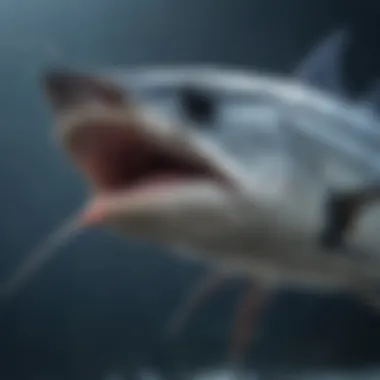Nutritional and Environmental Insights on Swordfish


Intro
Swordfish, known for its distinctive taste and firm texture, stands out in the seafood marketplace. However, its consumption brings forward conversations about nutritional benefits and environmental implications. As we dive into the complexities of swordfish, we will explore the nutritional profile, the associated health risks, its culinary versatility, and the sustainability challenges that accompany this popular marine species. This guide aims to provide a balanced perspective, aiding consumers, educators, and conservationists in their decision-making.
Animal Overview
Common Name and Scientific Classification
The common name of swordfish refers to Xiphias gladius. It belongs to the family Xiphiidae, a group of highly sought-after predatory fish. Understanding its scientific classification helps in appreciating its ecological role and its place in marine food chains.
Physical Characteristics
Swordfish are easily identifiable by their elongated bodies and notable bill-like snouts. They have a streamlined shape that allows them to swim swiftly through the water. Adult swordfish can weigh between 200 to 400 pounds and grow up to 11 feet in length, making them one of the larger fish sought in commercial fisheries. Their dark blue or brown body contrasts with a lighter underside, serving as effective camouflage in the ocean depths.
Habitat and Distribution
Swordfish inhabit warm and temperate waters globally, from the Atlantic and Pacific Oceans to the Gulf of Mexico. They prefer the surface waters but can also be found at depths of 600 feet or more. This adaptability allows them to evade predators and pursue prey, primarily smaller fish and squid. Their migratory patterns may vary seasonally as they follow their food sources.
Behavior and Social Structure
Communication Methods
Swordfish do not form schools. They are primarily solitary creatures, often found hunting alone or in small groups. Their communication methods remain largely unknown, but it is believed that they use body language and possibly vibrations to signal to one another in the vast ocean.
Social Hierarchies
Given their solitary nature, social hierarchy does not play a significant role in their behavior. Interactions among swordfish tend to be brief and revolve mostly around mating or competition for food.
Mating and Reproductive Behavior
Swordfish reach sexual maturity at around four years old. They typically spawn during the warmer months, releasing eggs and sperm into the water column. This process, known as broadcast spawning, allows for greater fertilization chances. Population dynamics depend heavily on the success of these spawning events.
Conservation Status
Current Population Trends
Recent assessments indicate fluctuations in swordfish populations, heavily influenced by fishing pressures. Sustainable practices are vital to ensure the longevity of this species in our oceans.
Threats and Challenges
Overfishing poses a significant threat to swordfish populations. Additionally, bycatch, the unintended capture of non-target species, is a challenge for sustainable fishing methods. Environmental changes, such as ocean warming and habitat degradation, further complicate their future.
Conservation Efforts and Success Stories
Various organizations and fisheries have implemented management strategies to help swordfish populations recover. These efforts include regulations on catch limits and the establishment of marine protected areas to enhance population sustainability. The success of these conservation projects relies on cooperation from both industries and consumers.
Understanding the balance between swordfish consumption and its environmental impact is crucial for making informed dietary choices.
By examining the nutritional and environmental aspects of swordfish consumption, we can ensure its place on our plates while protecting our oceans for the future.
Foreword to Swordfish
Swordfish holds a unique position in the realm of seafood. As a popular choice among consumers, it presents both nutritional benefits and environmental considerations. Understanding swordfish is essential for anyone who wants to make informed dietary decisions or engage in conservation discussions. In this section, we will dissect the fundamental characteristics of swordfish alongside its culinary acclaim.
Defining Swordfish
Scientific classification situates swordfish, or Xiphias gladius, in the family Xiphiidae. It is a large, migratory fish known for its elongated body and prominent bill. Swordfish inhabit warmer waters and are found in both the Atlantic and Pacific Oceans. Their size can reach up to 14 feet and weights over 1,000 pounds. This species plays a vital role in marine ecosystems, often influencing the population of prey species.
Moreover, their biological characteristics contribute to their health benefits and potential risks when consumed. For example, their position in the food chain can lead to elevated mercury levels, a concern that will be discussed later. Thus, having a grasp of what swordfish is and how it fits into marine biodiversity is essential for consumers and advocates alike.
Culinary Popularity
In culinary circles, swordfish stands out for its rich flavor and meaty texture. It is especially favored for grilling and broiling due to its firm flesh, which holds together well during cooking.
Its versatility allows it to be paired with a variety of flavors, ranging from citrus marinades to rich sauces. The ease of preparation contributes to its abundance on restaurant menus and home kitchens. Additionally, swordfish is available year-round, making it a reliable choice for consumers.
Health-conscious families often appreciate its nutritional profile, which includes high protein content and essential vitamins.


Despite its popularity, it is crucial to approach swordfish consumption thoughtfully, considering both its nutritional benefits and the environmental impact of its harvesting.
Continued discussions on sustainability practices and health risks associated with swordfish consumption are vital for a well-rounded understanding.
Nutritional Profile of Swordfish
The nutritional profile of swordfish is central to understanding its viability as a seafood choice. It offers a range of benefits that appeal to health-conscious consumers, chefs, and families. Swordfish is prized not only for its flavor but also for its rich nutrient content. As with any food source, it is important to comprehend both the advantages and considerations associated with its consumption. This section highlights key components, including protein, vitamins, minerals, and fatty acids, that contribute to the overall nutritional value of swordfish.
Protein Content
Swordfish is an excellent source of high-quality protein. A standard serving of swordfish, approximately 3.5 ounces, typically contains around 20-25 grams of protein. This is significant for individuals seeking to maintain or build muscle mass, particularly athletes and active families. Protein is crucial for the body's repair processes and is a fundamental component of muscle tissue. Unlike some plant-based protein sources, the protein from swordfish contains all nine essential amino acids, making it a complete protein option.
This makes swordfish an appealing choice for those who are reducing red meat consumption. Including swordfish in a balanced diet can aid in meeting daily protein requirements while providing essential nutrients needed for various bodily functions.
Vitamins and Minerals
Swordfish packs a substantial dose of important vitamins and minerals. Notably, it is rich in vitamin D, which is vital for bone health and immune function. A single serving can provide more than half of the recommended daily intake of vitamin D. This is beneficial for people who may not get enough sunlight exposure, especially in northern climates during the winter months.
Additionally, swordfish is a good source of B vitamins, including vitamin B12 and niacin. Vitamin B12 is crucial for nerve health and red blood cell production, while niacin supports metabolism and the nervous system. Other minerals found in swordfish include selenium, which acts as an antioxidant, and phosphorus, important for bone health.
In summary, the vitamins and minerals found in swordfish facilitate various biological functions and contribute significantly to an individual's overall nutrient intake.
Fatty Acids
Swordfish has a notable fatty acid profile. It contains omega-3 fatty acids, which are essential for cardiovascular health. Omega-3s help reduce inflammation, lower blood pressure, and may contribute to improved heart function. The levels of these fatty acids in swordfish, however, are moderate compared to other fish like salmon. Nevertheless, consuming swordfish can still support heart health when incorporated into a balanced diet.
Moreover, the fat content in swordfish is relatively low, particularly in comparison to fatty fish. This makes it a favorable option for those monitoring their fat intake while still wanting to benefit from healthy fats. Understanding the fatty acid composition is essential for consumers looking to make informed choices about their dietary fat sources.
Health Benefits of Swordfish
The consumption of swordfish comes with a variety of health benefits. Understanding these aspects is crucial, especially for those who prioritize nutrition in their diets. This section will examine how swordfish contributes to heart health, brain function, and muscle development, providing valuable insights for families, veterinarians, and wildlife biologists alike.
Heart Health
Swordfish is a rich source of omega-3 fatty acids, which are essential for cardiovascular health. Omega-3s can help reduce triglycerides and lower blood pressure, lowering the risk for heart diseases. A diet incorporating swordfish may also assist in reducing the formation of harmful blood clots and may decrease the risk of arrhythmias. This fish's high protein content offers an alternative to red meat, which is often higher in saturated fats. Consuming swordfish regularly can lead to better overall heart health, but one must remain cognizant of portion sizes due to mercury levels.
Brain Function
The nutrients found in swordfish, particularly omega-3 fatty acids, play a significant role in brain health. Omega-3s support cognitive function and are linked to a lower risk of Alzheimer's disease. Additionally, vitamin B12, abundant in swordfish, is vital for maintaining nerve cells and promoting mental clarity. Neurotransmitter production, which affects mood and concentration, can benefit from the nutrients found in swordfish. These factors make swordfish an appealing addition to the diets of individuals looking to improve their cognitive abilities or maintain mental sharpness as they age.
Muscle Development
Swordfish is high in protein, making it an excellent choice for muscle development and repair. Protein is crucial for bodybuilders, athletes, or anyone engaged in regular physical activity. The amino acids present in swordfish contribute to muscle synthesis and recovery, helping maintain a healthy physique. Furthermore, the presence of various vitamins, such as vitamin D, assists in calcium absorption, which is essential for bone strength. Incorporating swordfish into post-workout meals ensures that the body gets an adequate supply of nutrients needed for optimal recovery.
Eating swordfish not only supports various aspects of health but also offers culinary versatility, appealing to a wide range of tastes.
Through its numerous health benefits, swordfish emerges as a valuable dietary option, enhancing both physical and mental well-being. Families and individuals focused on health can navigate their choices with a better informed perspective on the advantages offered by this fish.
Potential Health Risks
The potential health risks associated with swordfish consumption are critical to understand for both consumers and health professionals. These risks can significantly influence dietary choices and necessitate education regarding safe consumption practices. This section focuses on three primary concerns: mercury levels, pregnancy considerations, and allergenic reactions.
Mercury Levels
Mercury accumulation in swordfish is a significant factor that impacts its safety for consumption. Swordfish is known to have higher mercury concentrations compared to many other seafood species. This metal can harm the nervous system, particularly in young children and developing fetuses. The U.S. Environmental Protection Agency (EPA) and the Food and Drug Administration (FDA) both caution that certain populations, including pregnant women and nursing mothers, should limit their intake of swordfish due to its mercury content.
High mercury levels in swordfish can lead to neurological and developmental problems in children.
To better manage risk, consumers should consider the following:
- Frequency of consumption: Limit swordfish to no more than once a week.
- Alternative fish: Opt for fish lower in mercury, such as sardines or salmon.
Pregnancy Considerations
Pregnant women must exercise caution when it comes to swordfish consumption. Due to its mercury levels, swordfish can pose risks to fetal development. Mercury exposure during pregnancy can lead to serious issues such as low birth weight and developmental delays. As a result, health guidelines recommend avoiding swordfish entirely during pregnancy. It is essential for expectant mothers to consult healthcare providers on dietary choices and seek safer seafood alternatives rich in nutrients, such as tilapia or trout.
Allergenic Reactions


Swordfish can also trigger allergic reactions in some individuals. While allergic reactions to fish are not as commonplace as other food allergies, they can be severe. Symptoms might include hives, swelling, difficulty breathing, or gastrointestinal issues. People with known fish allergies should avoid swordfish entirely. Additionally, individuals who have not previously consumed swordfish but have allergies to other fish types should be cautious, as cross-reactivity can occur.
Understanding the potential health risks of swordfish is vital. This knowledge enables informed decisions about consumption, especially for vulnerable populations such as pregnant women and young children. Adhering to dietary guidelines can support overall health while still allowing for the enjoyment of seafood.
Sustainability and Environmental Impact
Sustainability and environmental impact are crucial topics when discussing swordfish consumption. As consumers become more aware of their choices, understanding the effects of fishing practices on ecosystems is vital. Swordfish, being a popular seafood option, holds both a nutritional allure and environmental implications. The balance between enjoying this fish and ensuring that its population remains stable and that fishing methods are responsible is key.
Fishing Practices
The methods used to capture swordfish can have significant effects on marine life and habitats. Common practices include longlining and harpooning. Longlining involves using a single line with multiple baited hooks, which can unintentionally capture non-target species, such as seabirds, turtles, and sharks. This bycatch can lead to substantial ecological imbalances.
Conversely, harpooning, while more selective, also carries risks. It relies on traditional techniques that require skill and experience. Fishermen target swordfish directly, reducing chances of capturing unwanted species. However, this method is not as widely practiced as longlining, leading to a heavier reliance on less sustainable techniques.
Here are some considerations for responsible fishing practices:
- Avoiding bycatch: Utilizing gear that minimizes the catch of non-target species.
- Time and area restrictions: Implementing measures to fish in certain windows or regions to protect habitats during breeding seasons.
- Fisherman education: Training programs for sustainable methods.
Stock Levels
Understanding stock levels of swordfish is essential for assessing sustainability. Overfishing in the past has led to decreased populations, prompting regulations and guidelines. Organizations such as the International Commission for the Conservation of Atlantic Tunas (ICCAT) monitor stock assessments to ensure proper management of swordfish populations.
Current data indicate that some swordfish stocks are showing signs of recovery thanks to international regulations and fishing quotas. This progress underscores the importance of sustainable practices. High stock levels contribute not only to ecological balance but also to the economic viability of fisheries. Maintaining these stocks is critical for ensuring swordfish remains a viable seafood option.
Key statistics to consider:
- International fishing quotas are established to limit the number of swordfish caught annually.
- Stock recovery efforts are in place where fishing pressure was excessive in the past.
Certification Standards
Consumers can make informed choices by relying on certification standards that signify sustainability. Programs like the Marine Stewardship Council (MSC) and the Aquaculture Stewardship Council (ASC) provide certifications based on rigorous criteria. These standards ensure that seafood comes from well-managed fisheries and that environmental impacts are minimized.
When selecting swordfish, looking for such certifications can guide consumers towards more sustainable choices. Knowing the origin of one’s seafood not only informs dietary choices but also supports responsible fishing practices.
In summary, understanding these factors helps consumers appreciate the complexities surrounding swordfish consumption. This knowledge fosters better choices that respect marine ecosystems while maintaining the availability of swordfish as a food source.
Culinary Uses and Preparation
The culinary uses and preparation of swordfish hold great importance in understanding its role in modern gastronomy. This section highlights various methods of preparing swordfish, the best practices for cooking, and the flavor profiles that complement this seafood. Knowledge of these aspects not only enhances the eating experience but also aligns with the nutritional benefits discussed earlier.
Common Cooking Methods
Swordfish is versatile and can be prepared using several cooking methods. Here are some of the most popular options:
- Grilling: This is perhaps the most favored method. Grilling swordfish gives it a delightful char and maintains its moisture.
- Baking: Baking is a healthier option. It allows for easy seasoning and pairing with other ingredients.
- Searing: Quickly searing swordfish in a hot pan develops a rich flavor while keeping the inside tender.
- Steaming: Steaming is ideal if you wish to preserve the fish’s natural flavors and retain nutrients.
Swordfish is often prepared with varying degrees of doneness. Usually, it should be cooked until it reaches 145°F (63°C) to ensure safety. However, many chefs prefer it slightly less done for a softer texture.
Flavor Pairing
The rich flavor of swordfish warrants careful pairing with sides and accompaniments. Several ingredients naturally compliment swordfish, enhancing its taste. Here are some worthy mentions:
- Citrus: Lemons, limes, and oranges work well, cutting through the fish’s richness.
- Herbs: Fresh herbs like parsley, basil, and thyme add complexity to the dish.
- Spices: Smoked paprika, cumin, and black pepper offer depth and warmth.
- Salsas: Tropical salsas with mango or pineapple can add a refreshing contrast.
Selecting the right flavor combinations enhances the overall dining experience. A robust seasoning can elevate the dish significantly, making it more appealing.
Recipe Examples
To illustrate the culinary potential of swordfish, here are a few recipes that showcase this fish's versatility:
Grilled Swordfish Steaks
- Ingredients: Swordfish steaks, olive oil, lemon juice, garlic, salt, and pepper.
- Instructions: Marinate the steaks in olive oil, lemon juice, minced garlic, salt, and pepper for at least 30 minutes. Preheat the grill, cook for about 4-5 minutes on each side until marked and cooked through.
Swordfish Tacos


- Ingredients: Swordfish, taco shells, shredded cabbage, avocado, and lime.
- Instructions: Sear swordfish with spices. Flake the fish and fill taco shells with the fish, cabbage, and sliced avocado. Squeeze lime on top before serving.
Baked Swordfish with Tomato and Olive Salsa
- Ingredients: Swordfish filets, diced tomatoes, olives, garlic, and herbs.
- Instructions: Place swordfish filets in a baking dish, cover with tomato and olive mixture. Bake at 400°F (200°C) for 15-20 minutes until cooked through.
These recipes can serve as a starting point for creating delicious meals while embracing the unique characteristics of swordfish. Through experimentation, home cooks can refine their techniques and adjust flavors to suit personal preferences.
Cultural Significance of Swordfish
The cultural significance of swordfish is profound and multifaceted, serving not just as a gustatory delight but as a representation of culinary heritage in several regions. Thus, discussing its relevance offers insights into how a single fish can influence traditions, rituals, and social interactions. In many coastal communities, swordfish plays an integral role not only on the table but also in local folklore and traditions.
Culinary Traditions
Swordfish has long been celebrated in the cuisines of various cultures, particularly in Mediterranean and Pacific regions. In Italy, for example, swordfish is often grilled, marinated, or served in pasta dishes, showcasing its versatility. Its meaty texture and mild flavor make it a prime candidate for grilling, while its rich presence in Mediterranean cuisine contributes to various regional dishes.
In addition to preparation methods, cultural events often revolve around swordfish consumption. Festivals celebrating fishing traditions may highlight swordfish as a central offering, bringing families together to share meals and stories.
Furthermore, in places like Hawaii, swordfish is included in traditional dishes such as poke, where it is cubed and served with various seasonings. These practices underscore not only swordfish's culinary value but also its ability to strengthen communal bonds.
Symbolism in Various Cultures
Beyond its culinary aspects, swordfish carries symbolic meanings in various cultures. In some areas, it is seen as a symbol of strength and resilience, due to its formidable size and power in the ocean. In the context of fishing, successfully catching a swordfish can mark a rite of passage or signify a fisherman's skill.
Additionally, swordfish may symbolize prosperity and good fortune. In certain cultures, it is considered auspicious to serve swordfish during celebrations or key life events, reflecting an aspiration for abundance in the coming year.
In summary, swordfish transcends its identity as merely food. It embodies rich culinary traditions and powerful symbolism in cultures around the globe. Understanding these elements not only enriches the consumption experience but also reinforces the importance of preserving the traditions and practices surrounding swordfish.
“In many coastal communities, swordfish plays an integral role not only on the table but also in local folklore and traditions.”
The cultural significance of swordfish merits thoughtful consideration for those who enjoy this fish, highlighting the need to appreciate its role in both cuisine and culture.
Finale
Evaluating swordfish consumption is essential, given its nutritional and environmental implications. This article covered important elements that enlighten readers about both the benefits and risks associated with this seafood choice. The critical components of this discussion reflect its complexity, involving nutritional profiles, health benefits, risks, and sustainability practices.
Summary of Key Points
- Nutritional Profile: Swordfish provides ample protein, essential vitamins, and minerals. It is particularly rich in omega-3 fatty acids, which contribute to various health benefits.
- Health Benefits: Eating swordfish can promote heart health, enhance brain function, and assist muscle development. However, caution is advised due to potential mercury levels.
- Potential Health Risks: Mercury content, especially in larger fish, poses health concerns, particularly for certain demographics such as pregnant women. Allergic reactions can also occur in some individuals.
- Sustainability: Sustainable fishing practices and awareness of stock levels are vital in preserving swordfish populations. Certification standards help consumers make informed choices.
- Culinary Importance: Swordfish is versatile in the kitchen and holds significant cultural value across different cuisines. Proper preparation methods enhance its taste and appeal.
Final Thoughts on Swordfish Consumption
Deciding to include swordfish in one’s diet requires careful consideration of various factors. While swordfish is nutritious and offers significant health benefits, potential risks related to mercury must not be overlooked. Furthermore, choosing swordfish from sustainable sources ensures responsible consumption, addressing environmental concerns.
Engaging with swordfish consumption is not merely about personal health. Understanding its background can reflect one's values regarding nutrition and environmental stewardship. As individuals ponder their choices about swordfish, the information provided here serves as a foundation for informed decision-making, guiding responsible consumption practices.
References and Further Reading
In-depth understanding of swordfish consumption necessitates reliable references and further reading materials. This section highlights the significance of academic studies and sustainable seafood guides in shaping informed decisions regarding swordfish.
Academic Studies
Academic studies provide rigorously researched insights on various aspects of swordfish. These studies analyze nutritional content, health implications, and environmental impacts. They are crucial for several reasons:
- Evidence-based findings: Studies such as those published in journals like Marine Biology and Journal of Nutritional Science present data-backed conclusions about swordfish consumption.
- Assessment of health risks: Research focusing on mercury levels offers critical insights into the safety of swordfish, particularly for vulnerable populations.
- Sustainability evaluations: Studies often assess swordfish fishing practices, helping to highlight threats to fish populations and marine ecosystems.
“Reliable academic resources are essential for consumers to make educated choices about swordfish.”
Consulting these studies can deepen understanding and clarify often-confusing information regarding swordfish.
Sustainable Seafood Guides
Sustainable seafood guides are pivotal for consumers who value eco-conscious choices. These guides rank seafood based on sustainability criteria and fisheries management. Key elements include:
- Environmental impact: Guides evaluate how fishing practices affect marine environments. They highlight options that minimize harm to ecosystems.
- Fisheries certification: Reputable guides indicate products certified by organizations like the Marine Stewardship Council (MSC) or the Aquaculture Stewardship Council (ASC).
- Consumer empowerment: By providing accessible information, these guides encourage consumers to choose sustainably sourced seafood, including swordfish.
Recognizing reliable resources is essential for families, veterinarians, and wildlife biologists when considering swordfish as a dietary option.
For further reference and resources, individuals can visit:







